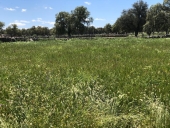
 2
2








Stephan Schwab wrote:Hi!
We would like to go back to a more natural way of feeding a lot of pigs...
Any ideas?
Each Iberian pig requires nearly 5 acres of grazing land, on average.




Creating edible biodiversity and embracing everlasting abundance.
 1
1




To lead a tranquil life, mind your own business and work with your hands.




Burl Smith wrote:
A "lot of pigs" would probably have to be kept in a sty while forage is mechanically harvested for them on intensively managed plots, in my opinion.




Hugo Morvan wrote:On the picture of the tall grass on the arm on your website, are those yellow flowers a local variety of Lotus corniculatus?
Hugo Morvan wrote:A clover variety, that would be a good start i'd say. Get a local clover variety, grow it on a destignated plot, and harvest those seeds then throw them around in cold season.
Hugo Morvan wrote:Maybe thistles break the hard soils up a bit with their deep tap roots as well, after rotting they make it easier for other plants to enter deeper into the soils.
Hugo Morvan wrote:
What nitrogen fixing shrubs are occuring naturally? Maybe try establishing Siberian Pea Shrub, it holds out here in France, or Robinia Pseudo Acacia.
Hugo Morvan wrote:
Those leaves could maybe serve as pig fodder, do i know? No, cause i know nothing of pigs. But i know you can get animals slowly used to eat what you have. And otherwise you got great stuff to chop and drop and build the soils that way, or get into goats to mulch on it if it has to be an animal that reduces the shrubs.




Mandy Launchbury-Rainey wrote:If you can grow some fast growing corn successionally, like those available from Carol Deppe, the pigs love the ears and the stalks, a huge amount of biomass for very few seeds. Also summer and winter squash. You may be able to keep enough to go through to spring/early summer.
Mandy Launchbury-Rainey wrote:
Get a huge comfrey patch growing and introduce the pigs to the leaves on a daily basis - great for nitrogen.
Mandy Launchbury-Rainey wrote:Put them in fields following cows to eat the manure. Then chickens to follow the pigs of course.
Mandy Launchbury-Rainey wrote:
The carcasses and leftover bits from chicken slaughtering includingnthe feathers, spare eggs from chickens and ducks, old potatoes and then plant 1st earlies which will come very early down there.
Mandy Launchbury-Rainey wrote:
Dried beans from last year and then fresh runnerbeans which are ztarting now. Gruellos, a type of turnip which give two crops of summer leaves, very popular up this end of the country. And grow fodder trees, goat willow, carob which does so well down there, siberian pea tree etc. From all that you should be able to grow enought to see you through. I do hope this helps.
 1
1




To lead a tranquil life, mind your own business and work with your hands.
 1
1




Creating edible biodiversity and embracing everlasting abundance.
 4
4






|
Something must be done about this. Let's start by reading this tiny ad:
Regionally adapted Midwest Seeds for the rest of US
http://flyoverseeds.com
|




